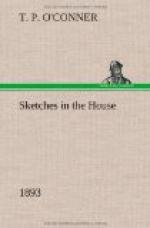[Sidenote: Randolph dull.]
Lord Randolph Churchill, rising on the following evening, was not at his best. He has been passing through what Disraeli once called a campaign of passion in the provinces; and his speeches have been full of the wildest fury. But all the fire had become extinguished. When Lord Randolph Churchill makes up his mind to be rational, few people in the House of Commons can be more rational; but when he makes up his mind to throw prudence, sense, and reserve to the winds, nobody can rise to such heights and descend to such depths of wild, unreasonable, bellowing Toryism—always, of course, excepting Ashmead-Bartlett. But when he is rational he is often dull—when he is unreasonable he is often very entertaining. The speech of April 18th was a rational speech—it was, therefore, a dull one. Lord Randolph is not what he was. The voice which was formerly so resonant has become muffled and sometimes almost indistinct, and the manner has lost all the sprightliness which used to relieve it in the olden days. The House of Commons is like the Revolution—it often swallows its own children.
[Sidenote: Father and son.]
Mr. Chamberlain might have been seen in two very different characters in the course of that same evening. He is not a soft man—amid sympathetic sniggers from all the House, Mr. Morley at a later stage referred sarcastically to the “milk of human kindness” which flowed so copiously in his veins—but he is a man of strong and warm domestic affections. He has the proud privilege of having in the House of Commons not only a son, but one who, in many respects, seems the very facsimile of himself, for the likeness between Mr. Austen Chamberlain and his father is startlingly close. This likeness is heightened by the similarity of dress—by the single eyeglass that is worn perennially in both cases, and, to a certain extent, by the walk. When the son began to speak this Tuesday night, there was even a stronger sense of the resemblance between the two. The voice was almost the same, the gestures were the same—the diction was not unlike—nearly all the tricks and mannerisms of the elder man were reproduced by the younger. For instance, when he is going to utter a good point, Mr. Chamberlain makes a pause—the son does the same: when Mr. Chamberlain is strongly moved, and wishes to drive home some fierce thrust, there is a deep swell in his otherwise even voice, and there is the same in the voice of the son. Then there is the same crisp, terse succession of sentences—altogether the likeness is wonderful.
[Sidenote: Mr. Chamberlain pleased.]




